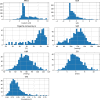Psychophysiology of positive and negative emotions, dataset of 1157 cases and 8 biosignals
- PMID: 35058476
- PMCID: PMC8776805
- DOI: 10.1038/s41597-021-01117-0
Psychophysiology of positive and negative emotions, dataset of 1157 cases and 8 biosignals
Abstract
Subjective experience and physiological activity are fundamental components of emotion. There is an increasing interest in the link between experiential and physiological processes across different disciplines, e.g., psychology, economics, or computer science. However, the findings largely rely on sample sizes that have been modest at best (limiting the statistical power) and capture only some concurrent biosignals. We present a novel publicly available dataset of psychophysiological responses to positive and negative emotions that offers some improvement over other databases. This database involves recordings of 1157 cases from healthy individuals (895 individuals participated in a single session and 122 individuals in several sessions), collected across seven studies, a continuous record of self-reported affect along with several biosignals (electrocardiogram, impedance cardiogram, electrodermal activity, hemodynamic measures, e.g., blood pressure, respiration trace, and skin temperature). We experimentally elicited a wide range of positive and negative emotions, including amusement, anger, disgust, excitement, fear, gratitude, sadness, tenderness, and threat. Psychophysiology of positive and negative emotions (POPANE) database is a large and comprehensive psychophysiological dataset on elicited emotions.
© 2022. The Author(s).
Conflict of interest statement
The authors declare no competing interests.
Figures



References
-
- Gross JJ. Emotion regulation: Current status and future prospects. Psychol. Inq. 2015;26:1–26.
-
- Mauss IB, Levenson RW, McCarter L, Wilhelm FH, Gross JJ. The tie that binds? Coherence among emotion experience, behavior, and physiology. Emotion. 2005;5:175–190. - PubMed
-
- Levenson RW. The autonomic nervous system and emotion. Emot. Rev. 2014;6:100–112.
-
- Mendes, W. B., & Park, J. in Advances in Motivation Science: Vol. 1 (ed. Elliot, A. J.) Neurobiological concomitants of motivational states. (Elsevier Academic Press, 2014).
Publication types
MeSH terms
Grants and funding
LinkOut - more resources
Full Text Sources

